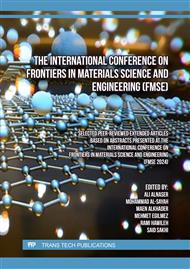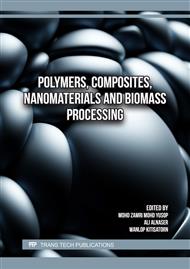[1]
J. Bu, Z. Tian, S. Zheng, and Z. Tang, "Effect of sand content on strength and pore structure of cement mortar," J. Wuhan Univ. Technol. Mater. Sci. Ed., vol. 32, no. 2, p.382–390, 2017.
DOI: 10.1007/s11595-017-1607-9
Google Scholar
[2]
K. Khan et al., "Effective use of micro-silica extracted from rice husk ash for the production of high-performance and sustainable cement mortar," Constr. Build. Mater., vol. 258, Oct. 2020.
DOI: 10.1016/j.conbuildmat.2020.119589
Google Scholar
[3]
R. Garg, R. Garg, M. Bansal, and Y. Aggarwal, "Experimental study on strength and microstructure of mortar in presence of micro and nano-silica," in Materials Today: Proceedings, Elsevier Ltd, 2020, p.769–777.
DOI: 10.1016/j.matpr.2020.06.167
Google Scholar
[4]
H. Y. Wang, W. Ten Kuo, C. C. Lin, and C. Po-Yo, "Study of the material properties of fly ash added to oyster cement mortar," Construction and Building Materials, vol. 41. p.532–537, 2013.
DOI: 10.1016/j.conbuildmat.2012.11.021
Google Scholar
[5]
L. G. Li, Z. H. Huang, J. Zhu, A. K. H. Kwan, and H. Y. Chen, "Synergistic effects of micro-silica and nano-silica on strength and microstructure of mortar," Constr. Build. Mater., vol. 140, p.229–238, Jun. 2017.
DOI: 10.1016/j.conbuildmat.2017.02.115
Google Scholar
[6]
J. M. Gao, C. X. Qian, B. Wang, and K. Morino, "Experimental study on properties of polymer-modified cement mortars with silica fume," Cem. Concr. Res., vol. 32, no. 1, p.41–45, Jan. 2002.
DOI: 10.1016/S0008-8846(01)00626-3
Google Scholar
[7]
L. Mollo, "Influence of cement/sand ratio on behavior of cement mortar," J. Eng. Des. Technol., vol. 13, no. 1, p.23–36, 2015.
DOI: 10.1108/JEDT-07-2012-0031
Google Scholar
[8]
E. S. S. Abu Seif, "Performance of cement mortar made with fine aggregates of dune sand, Kharga Oasis, Western Desert, Egypt: An experimental study," Jordan J. Civ. Eng., vol. 7, no. 3, p.270–284, 2013.
Google Scholar
[9]
S. Singh, P. Munjal, and N. Thammishetti, "Role of water cement ratio on the cement mortar," J. Build. Eng., vol. 4, no. September, p.94–100, 2015.
DOI: 10.1016/j.jobe.2015.09.003
Google Scholar
[10]
P. Shen, J. X. Lu, H. Zheng, S. Liu, and C. Sun Poon, "Conceptual design and performance evaluation of high strength pervious concrete," Constr. Build. Mater., vol. 269, p.121342, 2021.
DOI: 10.1016/j.conbuildmat.2020.121342
Google Scholar
[11]
K. J. Shin, S. C. Lee, and Y. Y. Kim, "Role of fine aggregates on mechanical properties of mortar," Mater. Res. Innov., vol. 19, no. March, p.690–692, 2015.
DOI: 10.1179/1432891715Z.0000000001778
Google Scholar
[12]
E. Lee, J. Ko, J. Yoo, S. Park, and J. Nam, "Analysis of the aggregate effect on the compressive strength of concrete using dune sand," Appl. Sci., vol. 11, no. 4, p.1–16, 2021.
DOI: 10.3390/app11041952
Google Scholar
[13]
H. Singh and S. Bansal, "EFFECT OF SILICA FUME ON THE STRENGTH OF CEMENT MORTAR," IJRET Int. J. Res. Eng. Technol., vol. 4, no. 2, 2015.
Google Scholar
[14]
L. Senff, D. Hotza, W. L. Repette, V. M. Ferreira, and J. A. Labrincha, "Effect of nanosilica and microsilica on microstructure and hardened properties of cement pastes and mortars," Adv. Appl. Ceram., vol. 109, no. 2, p.104–110, Feb. 2010.
DOI: 10.1179/174367509X12502621261659
Google Scholar
[15]
K. Khan et al., "Effective use of micro-silica extracted from rice husk ash for the production of high-performance and sustainable cement mortar," Constr. Build. Mater., vol. 258, p.119589, Oct. 2020.
DOI: 10.1016/J.CONBUILDMAT.2020.119589
Google Scholar
[16]
K. Al-Jabri and H. Shoukry, "Use of nano-structured waste materials for improving mechanical, physical and structural properties of cement mortar," Constr. Build. Mater., vol. 73, p.636–644, Dec. 2014.
DOI: 10.1016/J.CONBUILDMAT.2014.10.004
Google Scholar
[17]
M. Berra, F. Carassiti, T. Mangialardi, A. E. Paolini, and M. Sebastiani, "Effects of nanosilica addition on workability and compressive strength of Portland cement pastes," Constr. Build. Mater., vol. 35, p.666–675, Oct. 2012.
DOI: 10.1016/J.CONBUILDMAT.2012.04.132
Google Scholar
[18]
U. J. Alengaram, Valorization of industrial byproducts and wastes as sustainable construction materials. Elsevier Ltd, 2021.
DOI: 10.1016/B978-0-12-821730-6.00003-6
Google Scholar
[19]
ASTM Standards, "Standard Specification for Portland Cement," 2021.
DOI: 10.1520/C0150
Google Scholar
[20]
ASTM Standards, "Standard Specification for Slag Cement for Use in Concrete and Mortars," 2018.
DOI: 10.1520/C0989
Google Scholar
[21]
ASTM Standards, "Standard Specification for Silica Fume Used in Cementitious Mixtures," ASTM C1240 - 20, p.1–7, 2020.
Google Scholar
[22]
"Standard Test Method for Compressive Strength of Hydraulic Cement Mortars (Using 2-in. or [50 mm] Cube Specimens) 1".
DOI: 10.1520/C0109_C0109M-21
Google Scholar
[23]
"Standard Test Method for Flexural Strength of Hydraulic-Cement Mortars 1".
DOI: 10.1520/C0348-21
Google Scholar



